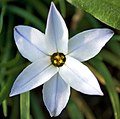Ipheion uniflorum
| Ipheion uniflorum | |
|---|---|

| |
| Scientific classification | |
| Kingdom: | Plantae |
| Clade: | Tracheophytes |
| Clade: | Angiosperms |
| Clade: | Monocots |
| Order: | Asparagales |
| Family: | Amaryllidaceae |
| Subfamily: | Allioideae |
| Genus: | Ipheion |
| Species: | I. uniflorum
|
| Binomial name | |
| Ipheion uniflorum | |
| Synonyms | |
Ipheion uniflorum is a species of flowering plant, related to the onions, placed in the allium subfamily (Allioideae) of the Amaryllidaceae.[1] It is known by the common name springstar,[2] or spring starflower. Along with all the species of the genus Ipheion, some sources place it in the genus Tristagma,[3] but research published in 2010 suggested that this is not correct.[4] It is native to Argentina and Uruguay, but is widely cultivated as an ornamental and reportedly naturalized in Great Britain, France, Australia, New Zealand [5] and the United States.[6]
Description[edit]
This is a small herbaceous perennial growing from a bulb and producing flat, shiny, green, hairless, grasslike leaves up to 30 cm (12 in) long. The foliage has an onionlike scent when crushed. The stem grows up to 20 cm (8 in) tall and bears a solitary showy flower in spring (hence the Latin name uniflorum - "single flower"). Each honey-scented, star-shaped flower has six pointed lobes up to 3 centimeters long in shades of very pale to deep purple-blue.
Cultivation[edit]
Ipheion uniflorum has been grown in the UK since 1820, when bulbs collected from near Buenos Aires arrived in the country. It is recommended for growing in a well-drained position outside or as a long-flowering pot plant in an unheated greenhouse. Various named forms are in cultivation, some of which may be hybrids. 'Wisley Blue' is a clear lilac blue; 'Froyle Mill' is a deeper violet blue; 'Album' is white. The cultivar 'Alberto Castillo', also white, has larger flowers and was collected in the 1980s by Alberto Castillo, the owner of Ezeiza Botanical Garden, from an abandoned Buenos Aires garden.[7][8] In the United States, the species is stated to be hardy to USDA Zone 5, and is recommended for massing in borders, alpine gardens and other areas, or it can be naturalized in lawns.[9]
The following cultivars have gained the Royal Horticultural Society's Award of Garden Merit:-[10]
Media[edit]
-
'Alberto Castillo'
-
Closeup of 'Rolf Fiedler'
References[edit]
- ^ Stevens, Peter F. (2001–2010), "Amaryllidaceae", Angiosperm Phylogeny Website, Version 10, retrieved 2010-11-30
- ^ USDA, NRCS (n.d.). "Tristagma uniflorum". The PLANTS Database (plants.usda.gov). Greensboro, North Carolina: National Plant Data Team. Retrieved 15 December 2015.
- ^ "Ipheion", World Checklist of Selected Plant Families, Royal Botanic Gardens, Kew, retrieved 2012-12-17
- ^ Souza, L.G.R; Crosa, O. & Guerra, M. (2010), "Karyological circumscription of Ipheion Rafinesque (Gilliesioideae, Alliaceae)", Plant Systematics and Evolution, 287 (3–4): 119–27, doi:10.1007/s00606-010-0304-3, S2CID 21914243
- ^ Kew World Checklist of Selected Plant Families, as Tristagma uniflorum
- ^ "Discover Life I. uniflorum Distribution Map". Discover Life.
- ^ Beckett, K., ed. (1993), Encyclopedia of Alpines, Vol. 1, Pershore, UK: AGS Publications, ISBN 978-0-900048-61-6, p.675
- ^ Rolfe, R. (2001), "Plant Awards 2000-2001", Bulletin of the Alpine Garden Society, 69: 482–550, p.488
- ^ Kemper Center for Home Gardening, Ipheion uniflorum, retrieved 2010-12-01
- ^ "AGM Plants - Ornamental" (PDF). Royal Horticultural Society. July 2017. p. 63. Retrieved 13 March 2018.
- ^ "RHS Plantfinder - Ipheion 'Alberto Castillo'". Retrieved 13 March 2018.
- ^ "RHS Plant Selector - Ipheion uniflorum 'Froyle Mill'". Royal Horticultural Society. Retrieved 2020-09-16.
- ^ "RHS Plant Selector - Ipheion uniflorum 'Rolf Fiedler'". Royal Horticultural Society. Retrieved 2020-09-16.
- ^ "RHS Plant Selector - Ipheion uniflorum 'Wisley Blue'". Royal Horticultural Society. Retrieved 2020-09-16.




